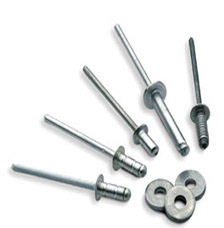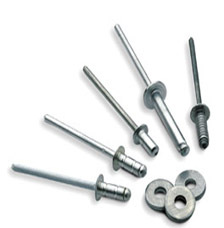Metal Fabrication
Choosing a Rivet Supplier for Sign Manufacturing
Nine riveting strategies to help your bottom line
Published
18 years agoon

The following article principally mimicks an article that originally appeared in the October 2001 issue of Electrical Contracting & Engineering News (EC&EN). Bob Reibel, president of American Rivet Co. (Franklin Park, IL), authored the article. For this column, ST has tailored the article for a sign-industry audience. ST wants to thank both Reibel and EC&EN for allowing us to re-present their work. Why use a rivet for sign manufacturing? Let’s review this fastener’s unique features, why it should be considered for sign-cabinet manufacturing, and how to select a rivet manufacturer and supplier. Here are the primary reasons for using rivets, which are applicable to many fabrication disciplines besides signmaking: Rivets can be fastened from just one side (inspired by WWI aircraft patchwork). In sign-cabinet manufacturing, reaching the rear surface to attach a nut on a large face can be problematic, if not impossible. Rivets are secure. They aren’t subject to disassembly like sheetmetal screws, nuts and bolts. Signs are usually made to weather years of service and don’t need to be disassembled. Service is usually provided from pre-planned access doors. Rivets sustain vibration better than screws, nuts and bolts. The latter also can come apart in shipping or be jarred loose due to vibration caused from wind and vehicular traffic. Rivets are automatically fed with low-cost production equipment, which cuts labor costs. Simple hand tools can set rivets. Rivets draw parts together, even when a gap exists between parts (pull-up strength). Often, there are several layers and thicknesses of materials. Screws usually can’t pull these parts together in the same manner as a rivet would. This is especially important when combining two plastics and metals. The rivet often protects the plastic from damage due to its controlled pull-up strength. Rivets add safety and prevent disassembly from pranks or sabotage — which may not have been a consideration before the events of September 11. In public-access areas, the rivet requires special removal procedures. Michael G. Peck, purchasing manager of Young Electric Sign Co. (Salt Lake City, UT) began working with sheetmetal in 1958, and dealt with rivets for 40 of those years. He says that using rivets expedites the manufacturing process by 30%. "You just make a number 30 drill-bit hole and pop it in," Peck says. "It also eliminates the problem of breaking off screw heads." He adds that some of the new automated screw-process machines the company has tried are difficult to adjust. Therefore, the rivet remains his fastener of choice. Removing rivets can be easy — if you remove the shank first. Otherwise, removing a sheetmetal, stainless-steel rivet can burn up drill bits. So, remove the shank and drill out the collar first. Again, this can be done from one side. Choosing a rivet supplier Consider the long-term costs of choosing a rivet supplier for a sign-manufacturing operation. Don’t be "penny wise and dollar foolish" by buying rivets on initial price alone. Know the costs of the entire manufacturing and distribution process. Peck uses two rivet suppliers and Pop™ Rivets (Sheldon, CT) as a manufacturer.
While your "penny-wise" competitors save 5% initially, your sign company can save more in the end as you maximize production, streamline delivery and maximize sales by manufacturing a better product in nine ways, which are:
1. Consider a rivet supplier who handles diverse design and material needs.
Find a supplier with a full range of rivet sizes and materials. Some suppliers won’t make stainless-steel rivets, which are more difficult to produce.
Your supplier should satisfy your present and future needs. These may include stainless steel for strength and corrosion resistance, or all-purpose industrial-grade steel. A good supplier will offer rivet sizes ranging from 0.038- to 0.375-in. in diameter in steel, brass, copper, aluminum, stainless steels, and even special finishes for ornamentation. Peck uses 10 types in steel, stainless steel and aluminum. Pop Rivets offers a hand tool for setting rivets.
Bob Reibel suggests using one supplier. "If you depend on many suppliers," he says, "you may be spending a significant amount of time coordinating contracts, reviewing quality systems and writing checks. You’ll save valuable time if you can find a one-stop supplier who meets and understands your needs."
Advertisement2. Consider a rivet supplier who uses optical and visual sorting to weed-out foreign parts that could disrupt production machinery.
Select a rivet supplier who thoroughly screens its products to ensure a uniform rivet size and type before shipping. Any given batch, especially large ones, may include stray rivets, which can cause high-volume, automated rivet feeders to jam. Two or three jams can lead to an hour of lost production time, which far outweighs any initial cost savings.
According to Jim Dlugopolski, director of purchasing for Appleton WI-based Material Management Group, a national inventory-management systems provider for OEMs, production stops may cost automotive OEMs up to $80,000 an hour. He adds, "Numbers like that add up fast. You have to make sure it doesn’t happen."
Although only large-quantity sign manufacturers would suffer from this problem, it’s still safer for smaller shops to choose a rivet supplier with high product-screening standards.
However, many suppliers selectively screen only for foreign parts, because they view this simply as their expense. When they screen, they typically don’t use roll sorting, which checks rivet heads for proper length, width and type as they travel down a series of rollers. Because of feeder jams and downtime, a short or narrow rivet can lead to an inferior sign.
Suppliers should use an optical sensor that checks rivets’ length and diameter. If a rivet doesn’t fit specifications, the optical sensor screens it out. A mechanical screen sort, which removes any foreign parts, should follow.
AdvertisementChoosing a Rivet Supplier for Sign Manufacturing
Nine riveting strategies to help your bottom line
Tim Brosnahan
3. Consider a rivet supplier with diverse, in-house equipment abilities to turn around special orders.
Out-of-stock rivets or design changes can halt production unless a supplier can promptly respond to a client’s needs. Owning one machine type limits a supplier to rigid lead times — overtime is not an option if a supplier has scheduled the machine for other uses. On the other hand, alternate machines offer more flexibility.
Reibel suggests that a supplier should have a high-speed rivet header and one to four die machines that allow complex part forming.
AdvertisementSign companies normally run small jobs, so find a supplier with a low minimum, such as 5,000 pieces. Typical industry minimums of 25,000-50,000 rivets would leave a small shop overstocked and poor. Peck orders 10,000 pieces of each type.
4. Consider a rivet supplier with an internal tool room.
Sign companies have few design changes because most rivet requirements are specified for cabinet fastening. However, a supplier with an internal tool room doesn’t need to outsource all design changes, which cause logistical problems and slow turnaround times. Ideally, a supplier should ship an order within 24 hours of receiving last-minute specification changes. This often requires an internal tool room.
5. Rivet suppliers with internal annealing and plating abilities speed turnaround time.
Annealing reduces stress after cold heading and facilitates rolling and using parts, but few suppliers own the requisite furnace ovens. Reibel says that good suppliers offer atmospherically controlled annealing ovens that can soften materials down to RB35 ("RB" refers to "Rockwell B Scale." See http://lennon.csufresno. edu~gmp30/alp5.html). He adds that the supplier should also offer drilling, tapping, threading, knurling and head slotting.
6. Consider a supplier who provides accurate information for new accounts and improves your relationship with existing ones.
Production turnaround is important, so the right supplier should provide timely quotes and specific information. Sometimes, same-day turnaround accompanies the winning bid. A streamlined supplier relationship provides key information that protects you from losing potential sales. Existing customers may also require same-day quotation turnaround.
7. Choose a rivet supplier who provides practical, hands-on riveting advice.
A rivet should be chosen for its permanent fastening ability. Sometimes, rivets don’t fasten properly. That’s when experienced, in-plant advice makes the difference. The problem may stem from the rivet, tooling, machine alignment or production configuration. In any event, a quick answer is vital.
8. Consider a rivet supplier who acts on a sign company’s needs.
Suppliers should be accessible by phone, fax, Internet, EDI, etc. They should confirm purchase orders, regardless of size, and ship rivets in plastic bags, cartons or other special packaging on request. Variable order requirements should be filled as needed.
Dlugopolski says, "A supplier who accepts variable order quantities, as well as low-order minimums, can add significantly to the bottom line. Instead of ordering large quantities once or twice a year and sitting on the inventory, a sign company may prefer to buy smaller quantities quarterly, bimonthly or monthly. Free up your cash for better uses than stockpiling inventory."
Peck says he orders rivets monthly, adding that prices have been steady for a year.
9. Consider a rivet supplier’s location.
Location may be the least important factor to sign companies. However, a rivet supplier located near metal-producing companies, platers, heat treaters and other industry specialists speeds turnaround time and lowers freight costs. A single rivet supplier can’t satisfy every specialized, riveting need.
Consider the fastening processes of your signshop. Can you improve sign manufacturing with the use of rivets or automated riveting pro-cesses? Do you need to review with your purchasing agent your present rivet supplier requirements? For more information, see www.pop-rivet.com and www.industrialholdings.com.
Here are examples of Pop™ rivets used in the sign industry. They comprise all-purpose industrial grade steel, corrosion resistant stainless steel and aluminum.
SPONSORED VIDEO
Introducing the Sign Industry Podcast
The Sign Industry Podcast is a platform for every sign person out there — from the old-timers who bent neon and hand-lettered boats to those venturing into new technologies — we want to get their stories out for everyone to hear. Come join us and listen to stories, learn tricks or techniques, and get insights of what’s to come. We are the world’s second oldest profession. The folks who started the world’s oldest profession needed a sign.
You may like
Advertisement
Subscribe

Magazine
Get the most important news
and business ideas from Signsofthetimes Magazine.
Advertisement
Most Popular
-

 Tip Sheet1 week ago
Tip Sheet1 week agoAlways Brand Yourself and Wear Fewer Hats — Two of April’s Sign Tips
-

 Photo Gallery2 days ago
Photo Gallery2 days ago30 Snapshots of the 2024 ISA Sign Expo
-

 Ask Signs of the Times4 days ago
Ask Signs of the Times4 days agoWhy Are Signs from Canva so Overloaded and Similar?
-

 Real Deal1 week ago
Real Deal1 week agoA Woman Sign Company Owner Confronts a Sexist Wholesaler
-

 Benchmarks7 days ago
Benchmarks7 days ago6 Sports Venue Signs Deserving a Standing Ovation
-

 Women in Signs1 week ago
Women in Signs1 week ago2024 Women in Signs: Megan Bradley
-

 Photo Gallery1 week ago
Photo Gallery1 week ago21 Larry Albright Plasma Globes, Crackle Tubes and More
-

 Women in Signs1 week ago
Women in Signs1 week ago2024 Women in Signs: Ashley Borell











